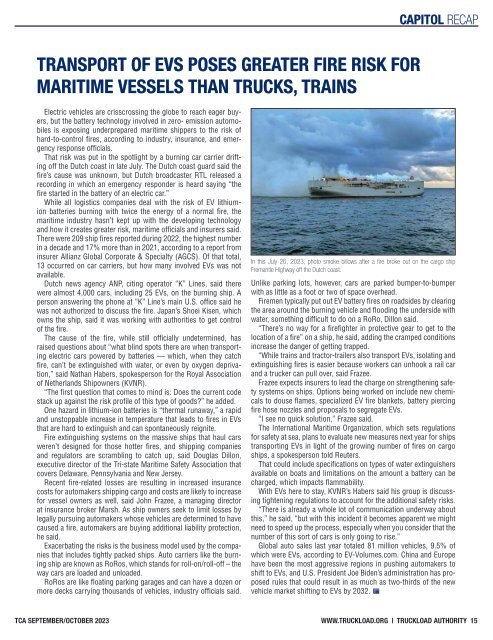TLA62_AllPages
You also want an ePaper? Increase the reach of your titles
YUMPU automatically turns print PDFs into web optimized ePapers that Google loves.
CAPITOL recap<br />
Transport of EVs poses greater fire risk for<br />
maritime vessels than trucks, trains<br />
Electric vehicles are crisscrossing the globe to reach eager buyers,<br />
but the battery technology involved in zero- emission automobiles<br />
is exposing underprepared maritime shippers to the risk of<br />
hard-to-control fires, according to industry, insurance, and emergency<br />
response officials.<br />
That risk was put in the spotlight by a burning car carrier drifting<br />
off the Dutch coast in late July. The Dutch coast guard said the<br />
fire’s cause was unknown, but Dutch broadcaster RTL released a<br />
recording in which an emergency responder is heard saying “the<br />
fire started in the battery of an electric car.”<br />
While all logistics companies deal with the risk of EV lithiumion<br />
batteries burning with twice the energy of a normal fire, the<br />
maritime industry hasn’t kept up with the developing technology<br />
and how it creates greater risk, maritime officials and insurers said.<br />
There were 209 ship fires reported during 2022, the highest number<br />
in a decade and 17% more than in 2021, according to a report from<br />
insurer Allianz Global Corporate & Specialty (AGCS). Of that total,<br />
13 occurred on car carriers, but how many involved EVs was not<br />
available.<br />
Dutch news agency ANP, citing operator “K” Lines, said there<br />
were almost 4,000 cars, including 25 EVs, on the burning ship. A<br />
person answering the phone at “K” Line’s main U.S. office said he<br />
was not authorized to discuss the fire. Japan’s Shoei Kisen, which<br />
owns the ship, said it was working with authorities to get control<br />
of the fire.<br />
The cause of the fire, while still officially undetermined, has<br />
raised questions about “what blind spots there are when transporting<br />
electric cars powered by batteries — which, when they catch<br />
fire, can’t be extinguished with water, or even by oxygen deprivation,”<br />
said Nathan Habers, spokesperson for the Royal Association<br />
of Netherlands Shipowners (KVNR).<br />
“The first question that comes to mind is: Does the current code<br />
stack up against the risk profile of this type of goods?” he added.<br />
One hazard in lithium-ion batteries is “thermal runaway,” a rapid<br />
and unstoppable increase in temperature that leads to fires in EVs<br />
that are hard to extinguish and can spontaneously reignite.<br />
Fire extinguishing systems on the massive ships that haul cars<br />
weren’t designed for those hotter fires, and shipping companies<br />
and regulators are scrambling to catch up, said Douglas Dillon,<br />
executive director of the Tri-state Maritime Safety Association that<br />
covers Delaware, Pennsylvania and New Jersey.<br />
Recent fire-related losses are resulting in increased insurance<br />
costs for automakers shipping cargo and costs are likely to increase<br />
for vessel owners as well, said John Frazee, a managing director<br />
at insurance broker Marsh. As ship owners seek to limit losses by<br />
legally pursuing automakers whose vehicles are determined to have<br />
caused a fire, automakers are buying additional liability protection,<br />
he said.<br />
Exacerbating the risks is the business model used by the companies<br />
that includes tightly packed ships. Auto carriers like the burning<br />
ship are known as RoRos, which stands for roll-on/roll-off – the<br />
way cars are loaded and unloaded.<br />
RoRos are like floating parking garages and can have a dozen or<br />
more decks carrying thousands of vehicles, industry officials said.<br />
In this July 26, 2023, photo smoke billows after a fire broke out on the cargo ship<br />
Fremantle Highway off the Dutch coast.<br />
Unlike parking lots, however, cars are parked bumper-to-bumper<br />
with as little as a foot or two of space overhead.<br />
Firemen typically put out EV battery fires on roadsides by clearing<br />
the area around the burning vehicle and flooding the underside with<br />
water, something difficult to do on a RoRo, Dillon said.<br />
“There’s no way for a firefighter in protective gear to get to the<br />
location of a fire” on a ship, he said, adding the cramped conditions<br />
increase the danger of getting trapped.<br />
“While trains and tractor-trailers also transport EVs, isolating and<br />
extinguishing fires is easier because workers can unhook a rail car<br />
and a trucker can pull over, said Frazee.<br />
Frazee expects insurers to lead the charge on strengthening safety<br />
systems on ships. Options being worked on include new chemicals<br />
to douse flames, specialized EV fire blankets, battery piercing<br />
fire hose nozzles and proposals to segregate EVs.<br />
“I see no quick solution,” Frazee said.<br />
The International Maritime Organization, which sets regulations<br />
for safety at sea, plans to evaluate new measures next year for ships<br />
transporting EVs in light of the growing number of fires on cargo<br />
ships, a spokesperson told Reuters.<br />
That could include specifications on types of water extinguishers<br />
available on boats and limitations on the amount a battery can be<br />
charged, which impacts flammability.<br />
With EVs here to stay, KVNR’s Habers said his group is discussing<br />
tightening regulations to account for the additional safety risks.<br />
“There is already a whole lot of communication underway about<br />
this,” he said, “but with this incident it becomes apparent we might<br />
need to speed up the process, especially when you consider that the<br />
number of this sort of cars is only going to rise.”<br />
Global auto sales last year totaled 81 million vehicles, 9.5% of<br />
which were EVs, according to EV-Volumes.com. China and Europe<br />
have been the most aggressive regions in pushing automakers to<br />
shift to EVs, and U.S. President Joe Biden’s administration has proposed<br />
rules that could result in as much as two-thirds of the new<br />
vehicle market shifting to EVs by 2032.<br />
TCA SEPTEMBER/OCTOBER 2023 www.Truckload.org | Truckload Authority 15

















